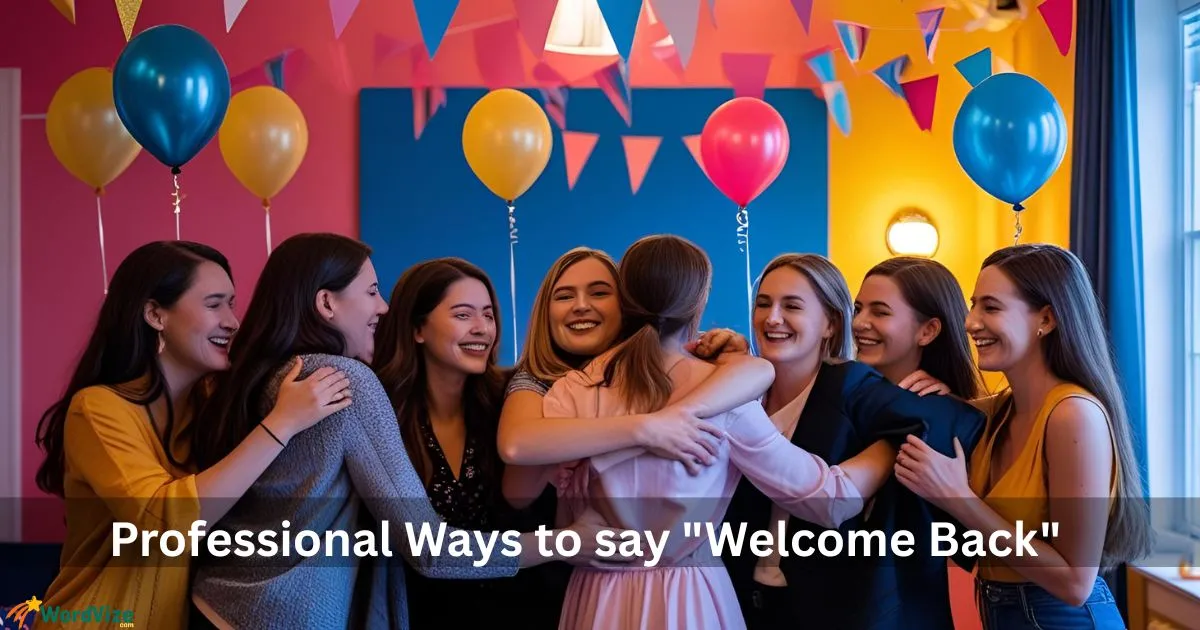Reintroducing someone with “Welcome Back” can seem simple, but how you say it matters in professional settings. If you’re greeting a returning colleague, client, or business partner, the right words can set the tone for collaboration and success.
As someone who’s navigated the challenges of workplace communication, I’ve learned that choosing the right phrases can make all the difference.
In this article, I’ll share over 23 professional alternatives to “welcome back” that will help you make a lasting impression, enhance your communication skills, and foster stronger relationships.
After reading my post you can easily copy and paste of these ways that you want to sent your friend, just select those way that you want to sent your friends or family members or favorites and click on copy button and sent it. These way you can share with you WhatsApp groups and social media groups.
List of Professional Ways to say “Welcome Back”
- Thrilled to see you back
- Feels great to have you here again
- So glad you’re back in the mix
- Excited to have you back with us
- It’s wonderful to see you again!
- Nice to see you again
- Great to have you back
- Good to see you again
- Glad to have you back
- Welcome home
- Happy to see you again
- It’s been a while!
- Look who’s back!
- Long time no see
- We missed you
- Back in action!
- You’re back! Awesome!
- Nice to have you back
- It’s good to have you around again
- Home sweet home!
- Welcome back on board
- Back to the grind!
- Reunited at last!
- Good to have you with us again
- So happy to see you back
1.Thrilled to see you back
Definition:
“Thrilled to see you back” is a warm and enthusiastic greeting that expresses genuine excitement upon someone’s return. It conveys a sense of joy and appreciation for their presence.
Explanation:
When you say you’re “thrilled” to see someone, it shows you’re more than just happy they’ve been missed, and their return brings positive energy. This phrase has an emotional impact, showing deep appreciation for the person’s return. It’s often used in both personal and professional settings, enhancing the connection and showing warmth.
Incorporates Practical Usage Examples:
- A manager might say, “We’re thrilled to see you back after your vacation; your expertise was definitely missed!”
- A close friend could use this phrase during a reunion, like, “I’m thrilled to see you back after all these years!”
Description:
I’ve found that using phrases like “thrilled to see you back” helps create an instant positive atmosphere and sets the tone for re-engagement. If in the office or in a social setting, it communicates not just excitement but also recognition of the person’s value and contribution. In my own experience, using such welcoming language fosters a strong, welcoming culture that builds rapport and encourages meaningful interactions.
2. Feels great to have you here again
Definition:
“Feels great to have you here again” is a sincere phrase that conveys warmth and appreciation for someone’s return. It signals that their presence truly makes a difference.
Explanation:
This expression highlights how meaningful it is to have someone back, especially in settings where personal connection or team spirit matters. It feels natural and human, often used when you want to make the returning person feel both welcomed and valued.
Incorporates Practical Usage Examples:
- A colleague returning from a break might hear, “It feels great to have you here again. Things weren’t the same without you.”
- During a casual get-together, a friend might say, “It feels great to have you here again. We really missed you.”
Description:
From my perspective, this phrase works wonders in reinforcing positive workplace culture or community bonds. I’ve used it in team meetings to acknowledge returnees in a heartfelt way, and it always lands well. It combines emotional connection with genuine respect, making it ideal for both formal and friendly settings.
3. So glad you’re back in the mix
Definition:
“So glad you’re back in the mix” is a friendly, casual way of saying you’re happy someone has returned to their usual place or role. It implies that their presence contributes positively to the group or environment.
Explanation:
This phrase suggests that the person is an important part of a team, community, or workflow and that things feel more complete with them back. It’s often used in professional environments to re-engage a colleague and emphasize their value and involvement.
Incorporates Practical Usage Examples:
- A team leader might say, “We’ve missed your energy in meetings so glad you’re back in the mix!”
- After a team member returns to a group project, someone could say, “So glad you’re back in the mix we needed your insights.”
Description:
I’ve often used this phrase when welcoming back a teammate after time away. It carries a sense of team synergy and makes the person feel like they belong. It’s especially useful in collaborative environments where every person plays a key role. This type of language encourages inclusion and acknowledges each individual’s contribution.
4. Excited to have you back with us
Definition:
“Excited to have you back with us” is a professional and upbeat phrase that shows enthusiasm and anticipation for someone’s return to a shared space or team.
Explanation:
This phrase expresses both positive emotion and a sense of renewed connection. It’s particularly effective in workplace settings, helping people feel recognized and welcomed. It combines both emotional warmth and professional courtesy, making it versatile for various interactions.
Incorporates Practical Usage Examples:
- HR may say in an email, “We’re excited to have you back with us, we look forward to your continued success.”
- A team might greet a returning colleague with, “Excited to have you back with your ideas always spark great conversations!”
Description:
I’ve used this phrase in formal emails and team briefings, and it consistently sets a positive tone. It works well when trying to reinforce company culture and team morale. The wording shows respect and enthusiasm, which helps rebuild momentum after someone returns.
5. It’s wonderful to see you again!
Definition:
“It’s wonderful to see you again!” is a warm, classic expression of joy and reunion. It emphasizes the positive emotional impact of seeing someone after a time apart.
Explanation:
This phrase works well in both personal and professional settings. It expresses genuine happiness and reflects a polite, sincere tone. It also holds a sense of respect and care, which makes it ideal for meaningful reunions.
Incorporates Practical Usage Examples:
- At a networking event, someone might say, “It’s wonderful to see you again! We haven’t spoken since the last conference.”
- A team leader might greet a returning employee with, “It’s wonderful to see you again! The team really missed you.”
Description:
In my experience, this phrase strikes the perfect balance between warmth and professionalism. I often use it when reconnecting with clients or collaborators. It’s timeless and communicates genuine appreciation, which helps rebuild relationships and sets a friendly tone for further interaction.
6. Nice to see you again
Definition:
“Nice to see you again” is a friendly and polite greeting used to express pleasure at someone’s return or reappearance. It’s simple, neutral, and universally appropriate.
Explanation:
This phrase is a versatile expression that works well in both formal and informal contexts. It’s commonly used in business meetings, casual catch-ups, and everyday encounters. It emphasizes recognition, familiarity, and a positive tone, helping rebuild rapport with ease.
Incorporates Practical Usage Examples:
- At a client meeting: “Nice to see you again, let’s pick up where we left off.”
- During a casual reunion: “Hey! Nice to see you again, how have you been?”
Description:
I often use this phrase when I want to keep things warm but professional. It shows respect without being overly emotional and fits well in any reconnection scenario. From conferences to coffee chats, it’s a great phrase to reestablish friendly communication.
7. Great to have you back
Definition:
“Great to have you back” expresses a strong sense of relief, joy, and appreciation for someone’s return, especially when their absence was noticeable.
Explanation:
This phrase sends a message that the person was missed and their presence matters. It’s ideal for both team dynamics and personal bonds, highlighting that things are better with them around. It also reflects a welcoming tone that strengthens group cohesion.
Incorporates Practical Usage Examples:
- After an employee returns: “Great to have you back, your input really drives the project forward.”
- Greeting a friend: “Great to have you back, we’ve got so much to catch up on!”
Description:
I’ve found this phrase effective in reinforcing belonging and recognition in teams. When someone’s been on leave, vacation, or a break, saying “Great to have you back” validates their role. It promotes positive morale and encourages smooth re-entry.
8. Good to see you again
Definition:
“Good to see you again” is a courteous, slightly formal way of expressing that someone’s return is a pleasant surprise or welcomed encounter.
Explanation:
This expression blends friendliness with professional polish, making it suitable for almost any environment. It helps rebuild rapport and eases people back into a conversation or space. It often conveys respect, especially when used in first-time return encounters.
Incorporates Practical Usage Examples:
- At a workplace: “Good to see you again, hope you had a restful break.”
- During a business event: “Good to see you again, I enjoyed our last conversation.”
Description:
I frequently use this phrase in professional settings when reconnecting with clients or colleagues. It maintains a warm tone while keeping things appropriate. Its simplicity and versatility make it a go-to greeting for smooth reconnections.
9. Glad to have you back
Definition:
“Glad to have you back” is a positive expression that communicates genuine happiness and relief at someone’s return.
Explanation:
This phrase creates a welcoming environment, particularly in settings where the person’s contributions or presence are important. It often implies the speaker values the person both professionally and personally. It’s clear, warm, and widely used to promote positive interactions.
Incorporates Practical Usage Examples:
- A team lead might say, “Glad to have you back, we missed your leadership.”
- A friend might greet you with, “Glad to have you back, your energy lights up the room!”
Description:
I use this phrase often when team members return after being away. It helps them feel appreciated and welcomed without being over the top. From my experience, this kind of positive language improves team morale and encourages quick reintegration.
Read this: Professional Ways to say Happy Birthday to best friend
10. Welcome home
Definition:
“Welcome home” is a warm, emotionally rich phrase that expresses comfort, belonging, and affection when someone returns to a familiar place or group.
Explanation:
Though traditionally used in personal settings, this phrase is also used metaphorically in workplaces or communities to show that the person is deeply missed and truly belongs. It holds strong emotional meaning and creates a sense of safety and acceptance.
Incorporates Practical Usage Examples:
- A family member might say, “Welcome home we’ve all missed you!”
- A team could say to a returning employee, “Welcome home to the team we’re stronger with you here.”
Description:
From my experience, this phrase is powerful when used with sincerity. It strengthens emotional bonds and reinforces a sense of community. When in families, organizations, or tight-knit teams, “Welcome home” is a reminder of trust, support, and belonging.
11. Happy to see you again
Definition:
“Happy to see you again” is a pleasant and sincere phrase used to express joyful recognition when reconnecting with someone after a break or absence.
Explanation:
This expression is warm without being overly emotional, making it ideal for both professional and personal contexts. It signals that the person’s return is noticed and appreciated, strengthening the sense of connection and rapport between people.
Incorporates Practical Usage Examples:
- A manager might say, “Happy to see you again, we’ve been looking forward to your return.”
- A friend may greet you with, “Happy to see you again, it’s been too long!”
Description:
In my experience, this phrase works beautifully to rebuild friendly energy in both team and social settings. It balances professionalism and emotional warmth, making it suitable for client follow-ups, peer greetings, or welcoming back familiar faces at events.
12. It’s been a while!
Definition:
“It’s been a while!” is a casual and expressive way to acknowledge that a significant amount of time has passed since the last meeting or interaction.
Explanation:
This phrase naturally starts conversations, often signaling a desire to reconnect or catch up. It carries a tone of nostalgia, familiarity, and interest, making it a strong opener in friendly or informal environments.
Incorporates Practical Usage Examples:
- Reuniting with a colleague: “It’s been a while! Great to see you back.”
- Greeting an old friend: “It’s been a while! We need to catch up.”
Description:
I’ve used this phrase in casual workplace conversations and networking events where time has passed between meetings. It encourages natural conversation flow and expresses a shared sense of time and curiosity about updates. It’s great for rekindling relationships.
13. Look who’s back!
Definition:
“Look who’s back!” is a playful, upbeat way to greet someone who has returned, often used with familiarity and excitement.
Explanation:
This phrase creates a sense of surprise and joy, perfect for close teams or friend groups. It breaks formality and adds energy to the moment, helping to spark a fun, easy-going interaction that shows the person was missed.
Incorporates Practical Usage Examples:
- A colleague returns from leave: “Look who’s back! Things are about to get interesting again.”
- A friend walks into a party: “Look who’s back! The fun just showed up!”
Description:
I’ve seen this phrase used to lighten the mood and instantly boost morale, especially in tight-knit teams. It’s energetic, relatable, and shows you’re genuinely glad to reconnect. This kind of phrasing brings out spontaneity and friendliness.
14. Long time no see
Definition:
“Long time no see” is an informal, conversational way to acknowledge someone’s return after a long gap in communication or presence.
Explanation:
This expression is casual and widely used across cultures to mark the passage of time. It sets the tone for a friendly catch-up and invites the other person to re engage. It’s often used with smiles, laughter, or a bit of playful nostalgia.
Incorporates Practical Usage Examples:
- Reconnecting at a café: “Hey, long time no see! How’s life treating you?”
- At the office after an extended leave: “Long time no see, it’s great to have you back!”
Description:
In my view, this phrase works well to start light-hearted conversations that revive past connections. It breaks down social tension and opens the door to casual dialogue. I’ve used it often when reuniting with clients or friends in social events.
15. We missed you
Definition:
“We missed you” is a warm, emotionally affirming phrase that expresses how someone’s absence was deeply felt and how valued they are.
Explanation:
This expression directly speaks to the emotional void someone left behind. It’s comforting and uplifting, showing the person that they truly matter. It builds emotional trust and is particularly meaningful in close teams, families, or communities.
Incorporates Practical Usage Examples:
- Returning to work: “We missed you, the meetings weren’t the same without you.”
- Coming home: “We missed you, it’s so good to see your face again!”
Description:
This is one of my favorite expressions for emotional reconnection. It’s deeply personal and creates an immediate bond. In both professional and personal contexts, saying “We missed you” is a gentle way to remind someone they are irreplaceable and appreciated.
16. Back in action!
Definition:
“Back in action!” is a lively, energetic phrase used to announce someone’s return to activity, often after a break, leave, or recovery.
Explanation:
This expression carries a tone of motivation and momentum, implying that things are about to get exciting or productive again. It’s great for casual, team-oriented settings where the person’s return marks the restart of progress or fun.
Incorporates Practical Usage Examples:
- After a sick leave: “She’s back in action and already tackling her tasks like a pro.”
- At practice: “Good to have you back in action, the team missed your energy!”
Description:
I’ve seen this phrase light up office environments. It creates a sense of renewed drive, especially when someone is back from a low phase or break. It’s ideal for settings where team morale, performance, or spirit gets a lift from their return.
17. You’re back! Awesome!
Definition:
“You’re back! Awesome!” is a casual, cheerful way to recognize someone’s return with enthusiasm and positivity.
Explanation:
This phrase signals immediate excitement, making the person feel noticed and appreciated. It’s perfect for informal environments where friendly, expressive language strengthens bonds and boosts emotional energy.
Incorporates Practical Usage Examples:
- Greeting a friend: “You’re back! Awesome! Let’s catch up soon.”
- In a team meeting: “You’re back! Awesome! We’ve got lots to fill you in on.”
Description:
Personally, I love how this phrase blends excitement and recognition in a natural way. When it’s a coworker, student, or friend, this greeting instantly boosts engagement and sends a strong welcome-back signal in just a few words.
18. Nice to have you back
Definition:
“Nice to have you back” is a gentle, affirming way to express gratitude for someone’s return and reaffirm their value in the group or setting.
Explanation:
This phrase is low-key but warm, offering a balanced tone for both casual and semi-professional situations. It reflects politeness and quiet appreciation, making it a go-to phrase in workplaces, schools, or social settings.
Incorporates Practical Usage Examples:
- After leaving: “Nice to have you back, we missed your insights in the meetings.”
- Rejoining a group: “Nice to have you back, things feel complete again.”
Description:
I often use this phrase when I want to keep the tone respectful and welcoming without sounding overly emotional. It’s versatile and fits any positive reentry moment, offering a smooth path to resume connection and collaboration.
19. It’s good to have you around again
Definition:
“It’s good to have you around again” expresses the idea that someone’s presence has a positive influence, and their return is genuinely welcome.
Explanation:
This phrase emphasizes the value of the person not just for what they do, but who they are. It signals a sense of belonging, comfort, and appreciation that resonates in close relationships or familiar teams.
Incorporates Practical Usage Examples:
- After a sabbatical: “It’s good to have you around again, your presence makes a big difference.”
- In family context: “It’s good to have you around again, everything feels normal now.”
Description:
I find this phrase incredibly useful when welcoming someone back to a familiar environment. It reinforces that their presence matters, not just their work. It’s perfect for emotionally intelligent communication that builds stronger interpersonal bonds.
20. Home sweet home!
Definition:
“Home sweet home!” is a cozy, heartfelt phrase that reflects the comfort and emotional safety of returning to a familiar place or group.
Explanation:
Often used when someone returns to a cherished space, this phrase evokes strong emotional nostalgia and warmth. When it’s a literal home or a metaphorical one like a team or friend group, it celebrates the idea of being back where you belong.
Incorporates Practical Usage Examples:
- Returning after travel: “Home sweet home! Nothing beats your own bed.”
- Rejoining a team: “Home sweet home! The vibe just wasn’t the same without you.”
Description:
This phrase never fails to bring a smile. It’s full of warmth and sentiment, making it ideal for informal situations where you want to highlight emotional connection. I use it when the return feels personal and heartfelt.
21. Welcome back on board
Definition:
“Welcome back on board” is a polite, professional way to greet someone returning to a team, workplace, or group, emphasizing collaboration and shared purpose.
Explanation:
This phrase is ideal for work-related settings where someone is resuming their role or rejoining the team. It conveys that their presence is important to the group’s mission or progress, promoting a sense of unity and belonging.
Incorporates Practical Usage Examples:
- A colleague returns from leave: “Welcome back on board, we’re ready to move forward together.”
- After rehiring an employee: “Welcome back on board, your expertise was missed.”
Description:
I often use this in client or team interactions because it carries a tone of respect and inclusion. It sets a positive, productive tone and affirms that the person’s skills and energy are essential to shared goals. It works well in onboarding, reboarding, or structured team dynamics.
22. Back to the grind!
Definition:
“Back to the grind!” is a casual, humorous phrase that recognizes someone’s return to routine work or responsibilities, often with a playful tone.
Explanation:
This phrase highlights the return to effort, hustle, or daily structure. It’s used in a light-hearted way, especially among colleagues or peers who want to acknowledge reality while keeping spirits high.
Incorporates Practical Usage Examples:
- After vacation: “Well, back to the grind! Let’s tackle that inbox.”
- At school after break: “Back to the grind! Time to hit the books again.”
Description:
I enjoy using this when the mood calls for light humor and mutual understanding. It reflects the shared truth that we all have duties, but also shows camaraderie. It’s excellent for easing transitions back to work with a smile and realistic mindset.
23. Reunited at last!
Definition:
“Reunited at last!” is a joyful, expressive phrase used to mark a long-awaited reunion, filled with emotion and excitement.
Explanation:
This phrase often signals a meaningful return when emotional, personal, or professional. It’s suitable when there’s relief, joy, or celebration tied to someone’s comeback, and it emphasizes the bond shared between people or teams.
Incorporates Practical Usage Examples:
- A best friend returns after months: “Reunited at last! I’ve missed our talks.”
- A team is whole again: “Reunited at last! Now we can crush this project.”
Description:
This phrase brings emotional depth and genuine connection. I’ve used it in heartfelt moments where reconnection feels powerful and significant. It amplifies the emotional value of someone’s presence and reminds everyone how much their return matters.
Also Seen this: Professional Ways to say “My Name is”
24. Good to have you with us again
Definition:
“Good to have you with us again” is a respectful, steady phrase used to acknowledge someone’s return with appreciation and professionalism.
Explanation:
This phrase works well in formal or semi-formal settings where the emphasis is on belonging and contribution. It’s affirming but not overly casual, showing that the person is valued and their presence makes a positive impact.
Incorporates Practical Usage Examples:
- In a meeting: “Good to have you with us again, your insights are always welcome.”
- At a team lunch: “Good to have you with us again, feels like the group is whole.”
Description:
I often use this when welcoming back team members or collaborators. It keeps the tone professional while still being personable. It reinforces that the person is appreciated, not just as a contributor, but as a valued part of the group dynamic.
25. So happy to see you back
Definition:
“So happy to see you back” is a heartfelt, genuine phrase used to express personal joy and warmth when someone returns.
Explanation:
This phrase goes beyond surface-level greetings to emphasize emotional appreciation. It shows that the return has a positive emotional impact on the speaker, If in a work, social, or family setting.
Incorporates Practical Usage Examples:
- A coworker returns after illness: “So happy to see you back, you’ve been missed every day.”
- At a family dinner: “So happy to see you back, it finally feels complete again.”
Description:
I use this when I want my gratitude and happiness to truly register. It’s especially powerful when someone has faced challenges or been away for a long period. It reaffirms emotional connection and shows they matter on a deeper level.
Conclusion
Mastering how to say “welcome back” with style and sincerity isn’t just about polite greetings; it’s about building deeper connections, reinforcing belonging, and creating positive emotional impact. As someone who’s worked across professional and social environments, I can confidently say that using the right phrase at the right time transforms ordinary reunions into meaningful moments.
Don’t just stick to the usual greetings explore these versatile, heartfelt alternatives. When you’re welcoming a colleague after leave, reconnecting with a friend, or greeting a customer, these phrases give you the tools to adapt with authenticity and empathy. Try rotating through the list to keep your tone fresh, your communication engaging, and your message memorable.

Hi, I’m Jaxon Hart, the Admin of wordvize.com a place where words come alive with smart synonyms, creative phrasing, and clear expression to elevate your writing every day.




